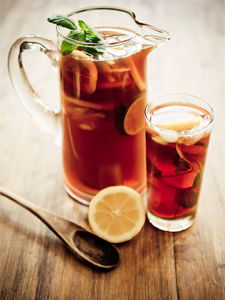Troubleshooting Iced Tea

Solution: Add more tea. Sometimes all it takes is an extra bag or two, or an extra teaspoon if you're working with loose leaves. Certain teas, like hibiscus, take better to cold water than others. Whites and greens, however, need a little more coaxing to release their flavor. Problem #2: It's bitter.
Solution: Cut the batch in half, add water, and resteep half as much tea in each new batch. A bitter batch usually occurs because you ran into Problem #1 and tried to fix it by letting the tea sit for an extra five minutes. Lesson learned, right? (Unless, of course, you like it that way. Oversteeped rosehip tea has a charming tendency to turn into Sour Patch Kids.) Problem #3: There's still not enough flavor.
Solution: Gussy it up. If you're used to RTD or teabags, and haven't yet had time to get chummy with loose leaf, then chances are that your palate is seeking more pronounced flavor. This scenario calls for extra ingredients: spices, herbs, fruit, and your preferred sugar to taste. Especially if you started off brewing a single origin tea—some are reluctant steepers when brewed cold. For instance, Chinese greens like Mao Jian have delicate flower-flavors that can be easily masked in the presence of ice cubes. To bring out the best in them, consider adding those complimentary flavors by borrowing the sangria method, steeping the tea with actual fruit. Problem #4: Nobody drinks it but you.
Solution: Not actually a problem. Congrats! You are now ready to make the best iced tea ever, and all types of tea can eagerly participate in your experiments. But occasionally the most adept mixologist may slip up. Too much sugar, or a spill of rooibos in the pot, and suddenly you have an undrinkable batch. Don't even bother to Instagram the mess. Laugh it off, dump it on the plants as fertilizer, and keep the story for your friends. (Much more entertaining than the one about your ex.)
